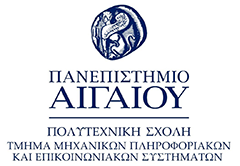Εκπαίδευση - Σπουδές
- Δίπλωμα Μηχανικού Πληροφορικής και Τηλεπικοινωνιών, Πανεπιστήμιο Δυτικής Μακεδονίας (2018)
- MSc. Διαδίκτυο των Πραγμάτων: Ευφυή Περιβάλλοντα σε Δίκτυα Νέας Γενιάς, Πανεπιστήμιο Αιγαίου (2020)
Ερευνητικά Ενδιαφέροντα
- Εφαρμογές Διαδικτύου των Πραγμάτων
- Δίκτυα Νέας Γενιάς και Πρότυπα Επικοινωνίας Ευφυών Συστημάτων
- Σχεδίαση και Ανάπτυξη Ευφυών Συστημάτων
Διδασκαλία
Δημοσιεύσεις σε Διεθνή Περιοδικά (Journals)
Copyright Notice: This material is presented to ensure timely dissemination of scholarly and technical work. Copyright and all rights therein are retained by authors or by other copyright holders. All persons copying this information are expected to adhere to the terms and constraints invoked by each author's copyright. In most cases, these works may not be reposted or mass reproduced without the explicit permission of the copyright holder.
Abstract
Smart farming has emerged as a promising approach to address the agriculture industry’s significant contribution to greenhouse gas (GHG) emissions. However, the effectiveness of current smart farming practices in mitigating GHG emissions remains a matter of ongoing debate. This review paper provides an in-depth examination of the current state of GHG emissions in smart farming, highlighting the limitations of existing practices in reducing GHG emissions and introducing innovative strategies that leverage the advanced capabilities of 6G-enabled IoT (6G-IoT). By enabling precise resource management, facilitating emission source identification and mitigation, and enhancing advanced emission reduction techniques, 6G-IoT integration offers a transformative solution for managing GHG emissions in agriculture. However, while smart agriculture focuses on technological applications for immediate efficiency gains, it also serves as a crucial component of sustainable agriculture by providing the tools necessary for long-term environmental supervision and resource sustainability. As a result, this study also contributes to sustainable agriculture by providing insights and guiding future advancements in smart farming, particularly in the context of 6G-IoT, to develop more effective GHG mitigation strategies for smart farming applications, promoting a more sustainable agricultural future.
Abstract
Throughout human history, agriculture has undergone a series of progressive transfor-
mations based on ever-evolving technologies in an effort to increase productivity and profitability.
Over the years, farming methods have evolved significantly, progressing from Agriculture 1.0, which
relied on primitive tools, to Agriculture 2.0, which incorporated machinery and advanced farming
practices, and subsequently to Agriculture 3.0, which emphasized mechanization and employed
intelligent machinery and technology to enhance productivity levels. To further automate and
increase agricultural productivity while minimizing agricultural inputs and pollutants, a new ap-
proach to agricultural management based on the concepts of the fourth industrial revolution is being
embraced gradually. This approach is referred to as “Agriculture 4.0” and is mainly implemented
through the use of Internet of Things (IoT) technologies, enabling the remote control of sensors and
actuators and the efficient collection and transfer of data. In addition, fueled by technologies such
as robotics, artificial intelligence, quantum sensing, and four-dimensional communication, a new
form of smart agriculture, called “Agriculture 5.0,” is now emerging. Agriculture 5.0 can exploit
the growing 5G network infrastructure as a basis. However, only 6G-IoT networks will be able
to offer the technological advances that will allow the full expansion of Agriculture 5.0, as can be
inferred from the relevant scientific literature and research. In this article, we first introduce the
scope of Agriculture 5.0 as well as the key features and technologies that will be leveraged in the
much-anticipated 6G-IoT communication systems. We then highlight the importance and influence
of these developing technologies in the further advancement of smart agriculture and conclude with
a discussion of future challenges and opportunities.
Επιστημονικά Συνέδρια (Conferences)
Copyright Notice: This material is presented to ensure timely dissemination of scholarly and technical work. Copyright and all rights therein are retained by authors or by other copyright holders. All persons copying this information are expected to adhere to the terms and constraints invoked by each author's copyright. In most cases, these works may not be reposted or mass reproduced without the explicit permission of the copyright holder.
Βιβλία
Copyright Notice: This material is presented to ensure timely dissemination of scholarly and technical work. Copyright and all rights therein are retained by authors or by other copyright holders. All persons copying this information are expected to adhere to the terms and constraints invoked by each author's copyright. In most cases, these works may not be reposted or mass reproduced without the explicit permission of the copyright holder.
Κεφάλαια σε Βιβλία
Copyright Notice: This material is presented to ensure timely dissemination of scholarly and technical work. Copyright and all rights therein are retained by authors or by other copyright holders. All persons copying this information are expected to adhere to the terms and constraints invoked by each author's copyright. In most cases, these works may not be reposted or mass reproduced without the explicit permission of the copyright holder.
Επιμέλεια Πρακτικών Διεθνών Συνεδρίων
Copyright Notice: This material is presented to ensure timely dissemination of scholarly and technical work. Copyright and all rights therein are retained by authors or by other copyright holders. All persons copying this information are expected to adhere to the terms and constraints invoked by each author's copyright. In most cases, these works may not be reposted or mass reproduced without the explicit permission of the copyright holder.





 Download
Download